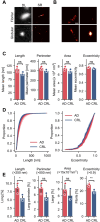Single-Molecule Characterization and Super-Resolution Imaging of Alzheimer's Disease-Relevant Tau Aggregates in Human Samples
- PMID: 38523073
- PMCID: PMC11497306
- DOI: 10.1002/anie.202317756
Single-Molecule Characterization and Super-Resolution Imaging of Alzheimer's Disease-Relevant Tau Aggregates in Human Samples
Abstract
Hyperphosphorylation and aggregation of the protein tau play key roles in the development of Alzheimer's disease (AD). While the molecular structure of the filamentous tau aggregates has been determined to atomic resolution, there is far less information available about the smaller, soluble aggregates, which are believed to be more toxic. Traditional techniques are limited to bulk measures and struggle to identify individual aggregates in complex biological samples. To address this, we developed a novel single-molecule pull-down-based assay (MAPTau) to detect and characterize individual tau aggregates in AD and control post-mortem brain and biofluids. Using MAPTau, we report the quantity, as well as the size and circularity of tau aggregates measured using super-resolution microscopy, revealing AD-specific differences in tau aggregate morphology. By adapting MAPTau to detect multiple phosphorylation markers in individual aggregates using two-color coincidence detection, we derived compositional profiles of the individual aggregates. We find an AD-specific phosphorylation profile of tau aggregates with more than 80 % containing multiple phosphorylations, compared to 5 % in age-matched non-AD controls. Our results show that MAPTau is able to identify disease-specific subpopulations of tau aggregates phosphorylated at different sites, that are invisible to other methods and enable the study of disease mechanisms and diagnosis.
Keywords: fluorescence microscopy; neurodegenerative disease; protein aggregation; proteins; single-molecule studies.
© 2024 The Authors. Angewandte Chemie International Edition published by Wiley-VCH GmbH.
Conflict of interest statement
The authors declare no conflict of interest.
Figures





Similar articles
-
Detecting the Undetectable: Advances in Methods for Identifying Small Tau Aggregates in Neurodegenerative Diseases.Chembiochem. 2025 Apr 1;26(7):e202400877. doi: 10.1002/cbic.202400877. Epub 2025 Jan 8. Chembiochem. 2025. PMID: 39688878 Free PMC article. Review.
-
Comparison of size distribution and (Pro249-Ser258) epitope exposure in in vitro and in vivo derived Tau fibrils.BMC Mol Cell Biol. 2020 Nov 12;21(1):81. doi: 10.1186/s12860-020-00320-y. BMC Mol Cell Biol. 2020. PMID: 33183222 Free PMC article.
-
Cerebral organoids with chromosome 21 trisomy secrete Alzheimer's disease-related soluble aggregates detectable by single-molecule-fluorescence and super-resolution microscopy.Mol Psychiatry. 2024 Feb;29(2):369-386. doi: 10.1038/s41380-023-02333-3. Epub 2023 Dec 15. Mol Psychiatry. 2024. PMID: 38102482 Free PMC article.
-
SynPull: An advanced method for studying neurodegeneration-related aggregates in synaptosomes using super-resolution microscopy.Cell Chem Biol. 2025 Feb 20;32(2):338-351.e4. doi: 10.1016/j.chembiol.2025.01.001. Epub 2025 Jan 24. Cell Chem Biol. 2025. PMID: 39862866
-
[Development of SPECT Probes for In Vivo Imaging of β-Amyloid and Tau Aggregates in the Alzheimer's Disease Brain].Yakugaku Zasshi. 2017;137(11):1361-1365. doi: 10.1248/yakushi.17-00156. Yakugaku Zasshi. 2017. PMID: 29093372 Review. Japanese.
Cited by
-
Aggregate-selective removal of pathological tau by clustering-activated degraders.Science. 2024 Aug 30;385(6712):1009-1016. doi: 10.1126/science.adp5186. Epub 2024 Aug 29. Science. 2024. PMID: 39208111 Free PMC article.
-
Ultrasensitive Protein Aggregate Quantification Assays for Neurodegenerative Diseases on the Simoa Platform.Anal Chem. 2025 Jan 14;97(1):290-299. doi: 10.1021/acs.analchem.4c04188. Epub 2024 Dec 24. Anal Chem. 2025. PMID: 39718440 Free PMC article.
-
Detecting the Undetectable: Advances in Methods for Identifying Small Tau Aggregates in Neurodegenerative Diseases.Chembiochem. 2025 Apr 1;26(7):e202400877. doi: 10.1002/cbic.202400877. Epub 2025 Jan 8. Chembiochem. 2025. PMID: 39688878 Free PMC article. Review.
-
Divergent disruptive effects of soluble recombinant tau assemblies on synaptic plasticity in vivo.Mol Brain. 2025 Apr 18;18(1):36. doi: 10.1186/s13041-025-01208-8. Mol Brain. 2025. PMID: 40251677 Free PMC article.
-
Clearance of beta-amyloid and tau aggregates is size dependent and altered by an inflammatory challenge.Brain Commun. 2024 Dec 14;7(1):fcae454. doi: 10.1093/braincomms/fcae454. eCollection 2025. Brain Commun. 2024. PMID: 39749010 Free PMC article.
References
Publication types
MeSH terms
Substances
Grants and funding
LinkOut - more resources
Full Text Sources
Other Literature Sources
Medical

